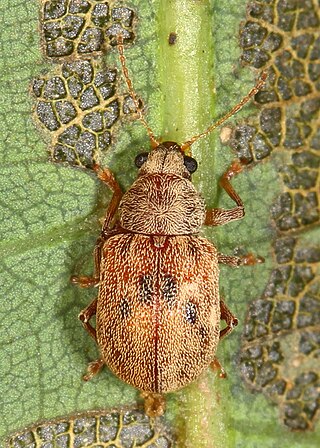
Colasposoma is a genus of leaf beetles in the subfamily Eumolpinae. It is known from Africa, Asia and Australia.

Platycorynus is a genus of leaf beetles in the subfamily Eumolpinae. Species of the genus are found in Africa and Asia.
Agathomerus is a genus of beetles in the family Megalopodidae, containing the following species:
Mastostethus is a genus of beetles in the family Megalopodidae, containing the following species:
Megalopus is a genus of beetles in the family Megalopodidae, containing the following species:

Colaspoides is a genus of leaf beetles in the subfamily Eumolpinae. It is one of the largest genera in the subfamily, containing over 260 species worldwide. It is an extant genus but there is at least one species, C. eocenicus, found in Baltic amber from the Upper Eocene of Russia, and the genus has also been reported from the Miocene of the Dominican Republic.

Macrocoma is a genus of leaf beetles in the subfamily Eumolpinae. It contains about 100 species, which are found in tropical Africa, around the Mediterranean, on the Canary Islands, in western and central Asia, and in India.

Lema is a genus of beetles in the family Chrysomelidae.

Eumolpini is a tribe of leaf beetles in the subfamily Eumolpinae. It is the largest tribe in the subfamily, with approximately 170 genera found worldwide. Members of the tribe almost always have a longitudinal median groove on the pygidium, which possibly helps to keep the elytra locked at rest. They also generally have a subglabrous body, as well as appendiculate pretarsal claws.

Demotina is a genus of leaf beetles in the subfamily Eumolpinae. There are over 50 described species in Demotina. The genus is native to Asia, Australia and Oceania, though one species is an adventive species in the southeastern United States in North America. Some species are known to be parthenogenetic.

Typophorini is a tribe of leaf beetles in the subfamily Eumolpinae. The tribe contains approximately 100 genera, which are found worldwide. Members of the tribe are mainly characterized by notches on the tibiae of the middle and hind legs, which are sometimes referred to as antenna cleaners. They also generally have a subglabrous body, as well as bifid pretarsal claws.
Hyperaxis is a genus of leaf beetles in the subfamily Eumolpinae. It is distributed in East and Southeast Asia.
Basilepta is a genus of leaf beetles in the subfamily Eumolpinae. It is generally distributed in Asia. A single species is also known from central Africa.

Heteraspis is a genus of leaf beetles in the subfamily Eumolpinae. The genus includes over 70 species, mainly from the Afrotropical, Palearctic and Oriental biogeographic realms. Only three species are found in Australia.
Cleoporus is a genus of leaf beetles in the subfamily Eumolpinae. It is known from Asia.

Trichochrysea is a genus of leaf beetles in the subfamily Eumolpinae. It is distributed in Asia.

Bromiini is a tribe of leaf beetles in the subfamily Eumolpinae. The tribe contains approximately 120 genera, which are found worldwide. They are generally thought to be an artificial group, often with a subcylindrical prothorax without lateral ridges and covered with setae or scales.











